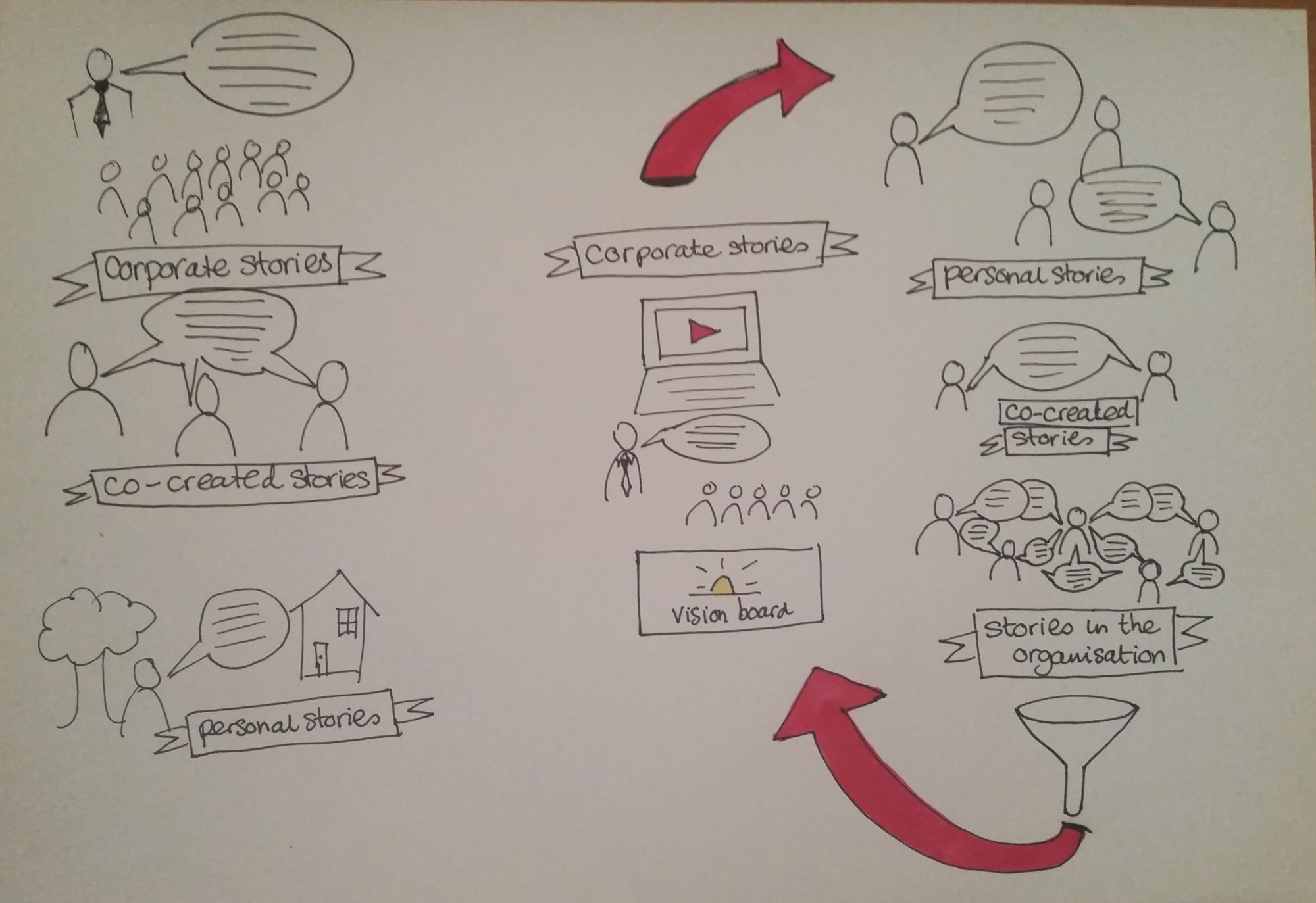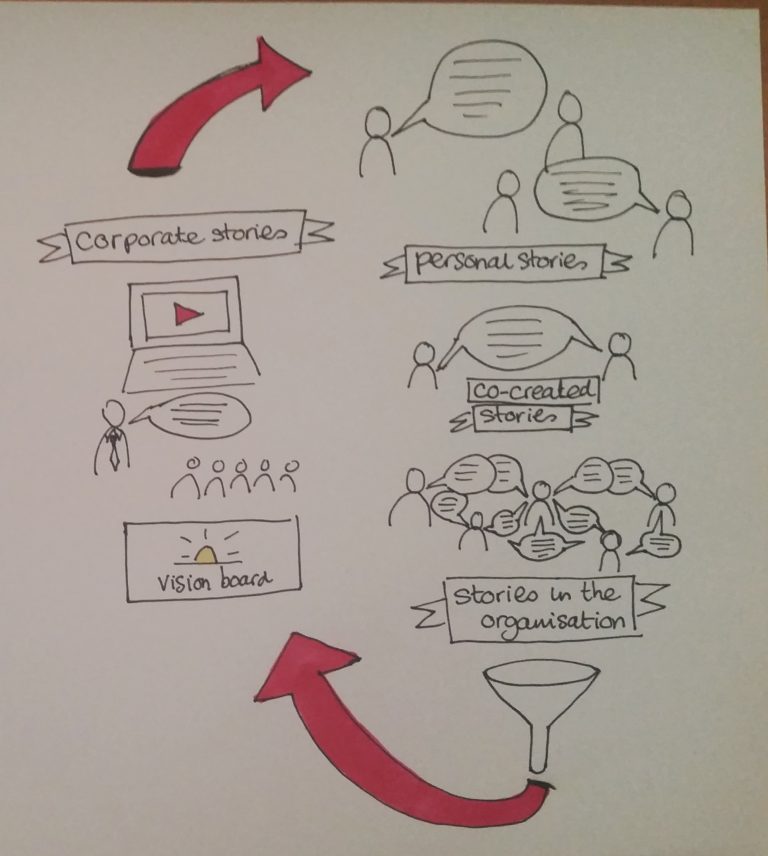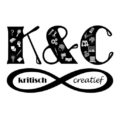
I recently began rereading some of the blogs and articles I had archived about storytelling. And reviewing and listening to video’s and podcasts I have saved. This is first of a few things I wanted to write down about the topic in order to disentangle my thoughts about it in the process. I hope to delve back into my own experiences as a storyteller in a large organization, helping other storytellers to do their work and to connect this to the ideas and experiences of other people I respect and admire. Feedback, responses and criticisms or questions are much appreciated as they help my clarify and question my own ideas.

Stodd and the old vs the new approach to story
Julian Stodd has written a lot about storytelling and it’s possible contribution to innovation, learning and growth in organizations. It is a crucial skill for the Social Leader to him. ( see https://julianstodd.wordpress.com/category/storytelling-2/ ) He also distinguishes between 3 types of stories and proposes a new order to them for the Social organization.
Corporate stories, co-created stories and personal stories, are all present in the organization at the same time. You can see these on the left in my drawing, represented in the old hierarchy, the order that these were considered to be relevant in. This is of course to some extent the straw man picture of old fashioned, larger organizations that Stodd agitates against.
Types of stories
The corporate stories contain the sign posts, the vision, the company values, the strategy that are communicated top down to management, and all the employees working under them.
The co -created stories contain the meaning, knowledge, myths and experiences shared among people. They can be widely different between the different departments and cliques in an organization. In the old hierarchy they are mostly seen as responding to the corporate story.
The personal stories can seem very irrelevant in this hierarchy. They may be typecast as inane stuff shared around the coffee machine and told amongst close co- workers or told to others -about the job- in the safety of the home and family. There is very little belief in the power of personal stories to change the corporate stories in the old system. Unless it happens to be the personal story of the CEO of course…. Then it’s called VISION. It goes without saying that nowadays -in the Social Age as Stodd calls it- many people have already started to recognize the importance of personal stories and how they drive commitment, and willingness to learn, grow and change in an organization. But so far the effect has been dampened by a centralized view of change management and a narrow focus on the importance of the personal stories of the upper echelons of the organization.
A new way of seeing
Stodd proposes a new hierarchy. And many people do alongside him. Professor in Implementation and Change Management Thijs Homan among them. He did a talk about change management in education at TedXAmsterdam in 2017 -that I highly recommend you take some time to see- to be found here : http://tedxamsterdamed.nl/talk/thijs-homan
Homan opposes the view that change only happens when it is managed. Change is always happening in organizations. And the conversations going on between people in organizations are a huge motor for this change. The stories they tell each other and the ones they formulate together help form the “mini-worlds” in the organization that Homan refers to. These worlds have their own order, connected to the shared stories, shared experiences and shared perceived reality of what is happening and what needs to be done about it that bind these mini worlds together.
Personal stories are where it all begins
I’ve tried to represent the new hierarchy of stories Stodd proposes on the right side of my drawing. I’ll reproduce it here in close-up.
It is a more realistic representation of the hierarchy of stories in an organization in one way. In other ways it is also an ideal to work towards. The ideal would be the self-conscious version of this model, constantly tweaking itself to be more effective. An ongoing experiment that seeks for the right stories to filter out and examines and improves the various constructive and destructive interactions between the separate types of stories and the filtering mechanisms that occur.
Stodd recognizes that personal stories are hugely important for learning and change in organizations. People are much more effective and driven when they are intrinsically motivated. Change and learning are- by definition- HARD things to achieve. You need to be willing to suffer- at least a little bit. And in order to be willing to sacrifice something, you need to believe in something. You need to believe you, or the world at large, or people you care for, will gain something in the long term through that short term sacrifice. This means that you need to give people room to talk about what they believe in, what and who they care about, what makes their work meaningful for them. To find out, through storytelling and conversation, what drives and motivates them. They need to be given space to turn inward, reflect and make their own meaningful stories that will hopefully connect their personal values and goals to what they are doing at work.
Connection is up next
So the next step is connection. Most organizations give a certain amount of room for collaborative storytelling about the corporate stories, some time for sense making about the vision and strategy as it relates to everyday work. The more specialized and highly educated people are, the more room they are given to do this, usually. But there is often a lot less room to work the other way around. To start from the personal and work via the everyday co- created stories with colleagues up to the level of helping to shape the corporate stories.
There is also a hierarchy in who is allowed to meddle with the corporate story. The people deemed more likely to make a valuable contribution are allowed more than those we have little regard for. Even if they work in the trenches of an organization and fight the fiercest every day battles. The higher up in the hierarchy you are, the more you feel able and allowed to make conscious choices. Choices about whether this company and the way they are handling things suits you, whether this team and the way they are working together suits you and how you can adjust your job and role in the organization to fit your strengths and motivation.
This freedom is earned by the responsibilities that come with filling important roles in the bigger picture, some would say. I sometimes doubt how well we asses people’s contributions though. Anyway, this sense of freedom often goes out the window in economic downfall. Uncertainty about the future and about job security or career opportunities let it evaporate. And it may be even more of a shock to high paid professionals than to people lower in the hierarchy when it goes. Because those working in the trenches have sometimes settled for division between a job (at work) and a life (at home) instead of seeing a career as a calling. But when you see your job as a calling and you are no longer able or allowed to do what you are called to do- because the organization is under a certain strain or making changes- people often buckle. Because the added responsibility and the pressure to perform is still there – and turned up a notch to boot. But the sustaining satisfaction and motivation are gone. And one without the other becomes toxic. And co-creation of story becomes near impossible when the truth of YOUR story is tied closely to your livelyhood and ‘survival’.
A FLOW of stories into the corporate narrative
Homan proposes in his talk that there is polycentric development going on in organizations all the time, change that starts in the mini-worlds in organizations because there is a demand and a need for it. Because people are driven. Because someone starts to experiment and the results turn out to have value. So more people adapt it , and still more. The idea of mono-centric change management does very little to help the best of the possible changes come to fruition in his view. In fact this type of change management can have an adverse effects if it spots some useful developments in a ‘mini-world’ and then tries to forcefully apply it to the whole organization within a set timeframe, without taking into account the different needs, pressures and ecosystems present in subcultures and sublevels of the organization..
The new hierarchy of story, or rather FLOW of stories Stodd proposes, paints an idealistic picture of everyone in the organization being able to start with freely telling their personal stories. Then continuing to connect these to the stories of their co- workers -bosses and underlings alike- to build co- created stories, that will spark mini-worlds and mini-changes like the ones that Homan describes. When these stories and changes are significant they should be picked up, examined and possibly slowly incorporated into the new corporate narrative.
If stories are allowed to be honest renditions of personal experiences in an organization- without censorship being applied to them. If the divide between what Homan call “on stage” and “off stage” behavior and the different “clouds of meaning” in the different mini-worlds is allowed to be bridged, even a little bit. If all this is possible (and it is a LOT to hope for) then change can possibly accelerate in a useful way. Then the corporate story is able to become -first- a more honest tale of the reality of the organization, the challenges that it faces, in both the monsters and disasters that attack and threaten it from the inside and in the outside threats and changes that it has to face. Given that new and more realistic picture of the organization, the second transformation comes: we can use this new reality as a backdrop to set a new corporate story about vision and strategy against. A tale of hope and belief about what the organization is hoping to accomplish and contribute, how it is hoping to do that and who in the world it is hoping to serve, without denying the -exiting but challenging- transitions that are waiting in the future in order to make this a reality.
Storytelling is always fiction, and so is this model….
Of course, this is a very idealistic picture. Real change and real learning are messy. Not only do a lot of experiments fail – and we should celebrate those failures and the lessons learnt!- but a lot of failed experiments also turn sour if there are not properly dealt with. If they are not examined for what they are worth and then respectfully closed down, but instead abandoned and left to simmer. Dysfunctional change, rotten mini-worlds and corrupting or untruthful stories that break an organization down -slowly but surely- are just a much a part of the reality of organizations as their shiny counterparts, that have the capacity to make the organization soar and improve.
Julian Stodd is very wise to warn about the power of story. As anyone who has ever read anything about propaganda can tell you, stories also have enormous power to corrupt. The storyteller role is hard, and fraught with dangers and moral implications. Something I’d like to reflect on further in later (set of) post(s) reflecting on my own experiences as a storyteller, caught between my own ideas and values and the conflicting drives and values at work in a large organisation. But when storytellers in the organization act like truth seekers, explorers and journalists they CAN unearth the seeds for growth and change in both the failed and the successful experiments, mini-worlds and tell their stories. They CAN help the best among them attract light and care and sustenance. And they CAN help us identify the weeds and pull them out early. Storytellers in the organization – when given the right amounts of freedom and responsibility – have the POTENTIAL to help the best stories spread and grow and become more and more true, more aligned with the values and vision of it’s employees and more and more in service of bringing an honest contribution to it’s customers and the world at large. If we can make this happen, then we have hold of a powerful agent for change for the better.


